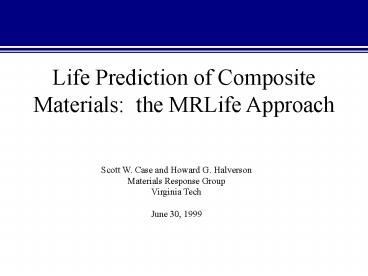Life Prediction of Composite Materials: the MRLife Approach - PowerPoint PPT Presentation
1 / 24
Title:
Life Prediction of Composite Materials: the MRLife Approach
Description:
Stress or Strength. Residual Strength. Life Curve. The Use of Remaining Strength as a State Variable ... Define a failure criterion, Fa, and a remaining ... – PowerPoint PPT presentation
Number of Views:164
Avg rating:3.0/5.0
Title: Life Prediction of Composite Materials: the MRLife Approach
1
Life Prediction of Composite Materials the
MRLife Approach
Scott W. Case and Howard G. Halverson Materials
Response Group Virginia Tech June 30, 1999
2
Objectives
- Develop methods for life prediction of composite
materials based upon residual strength approach - Apply the techniques to composite materials under
differing loading conditions and environments
3
Outline
- Residual strength approach to lifetime prediction
- Micromechanics/residual strength lifetime
prediction
4
The Use of Remaining Strength as a State Variable
- Track remaining strength during the fatigue
process - Define a scalar failure function based upon
tensor strength and stresses use this failure
function for calculations - May include the effects of changing loading
conditions - May be directly validated experimentally, unlike
Miners rule
Residual Strength
Sult
Stress or Strength
Life Curve
N1
Cycles
5
The Use of Remaining Strength as a State Variable
- Track remaining strength during the fatigue
process - Define a scalar failure function based upon
tensor strength and stresses use this failure
function for calculations - May include the effects of changing loading
conditions - May be directly validated experimentally, unlike
Miners rule
Residual Strength
Sult
Stress or Strength
Life Curve
N2
Cycles
6
The Use of Remaining Strength as a State Variable
- Track remaining strength during the fatigue
process - Define a scalar failure function based upon
tensor strength and stresses use this failure
function for calculations - May include the effects of changing loading
conditions - May be directly validated experimentally, unlike
Miners rule
Residual Strength
Sult
Stress or Strength
Miners rule
N1
N2
Cycles
7
The Use of Remaining Strength as a State Variable
- Track remaining strength during the fatigue
process - Define a scalar failure function based upon
tensor strength and stresses use this failure
function for calculations - May include the effects of changing loading
conditions - May be directly validated experimentally, unlike
Miners rule
Residual Strength
Sult
Stress or Strength
Life Curve
N1
N2
Cycles
8
The Use of Remaining Strength as a State Variable
- Track remaining strength during the fatigue
process - Define a scalar failure function based upon
tensor strength and stresses use this failure
function for calculations - May include the effects of changing loading
conditions - May be directly validated experimentally, unlike
Miners rule
Residual Strength
Sult
Stress or Strength
Life Curve
N1
N2
Cycles
9
Mathematical Representation
- Define a failure criterion, Fa, and a remaining
strength in terms of that failure criterion, Fr - Define a generalized time (for example n/N)
- Postuate change in remaining strength over the
interval - Fa is constant over
- For the special case in which is equal to zero
- Some possible choices for failure criteria
- Maximum stress/strain
- Tsai-Hill/Tsai-Wu
10
Mathematical Representation
- For step loading, introduce the concept of
"pseudo-cycles" based on the idea of equivalent
damage
11
Mathematical Representation
- Calculate change in remaining strength over the
interval - Calculate number of cycles required for failure
12
Approach for Variable Loading with Rupture and
Fatigue Acting
- Divide each step of loading into time increments
- Treat each increment as a stress rupture problem
(constant applied stress and temperature) - Reduce residual strength due to time dependent
damage accumulation - Refine number of intervals until residual
strength converges - Input next load level
- Check for load reversal. If load reversal,
increment by 1/2 cycle and reduce residual
strength due to fatigue damage accumulation
13
Stress Rupture Data for Nicalon/E-SiC 2-D Woven
Composite 0/902s
14
Fatigue Data for Nicalon/E-SiC 2-D Woven
Composite 0/902s
15
Residual Strength Data for Nicalon/E-SiC 2-D
Woven Composite 0/902s
16
Validation Mission Loading Profile
17
Validation Mission Loading Profile
18
Micromechanics of Combined Degradation Mechanisms
- Two particular damage mechanisms
- Slow crack growth
- Interfacial creep
- Analytic solution has not been develop ? use
simulation approach
19
Stress-Rupture Lifetime Prediction
Slow Crack Growth Modeling
Assume that crack growth is the mechanism for
fiber failure at elevated temperatures.
Crack growth is dictated by the Paris Law
So with time the strength of an individual fiber
is
Iyengar Curtin (1997)
20
Fiber Rupture Behavior
Obtain the fiber stress rupture parameters from
single fiber testing
Yun DiCarlo, 1993
21
Micromechanics of Combined Degradation Mechanisms
- Two particular damage mechanisms
- Slow crack growth
- Interfacial creep
- Analytic solution has not been develop ? use
simulation approach
22
Micromechanics of Combined Degradation
Mechanisms Both Mechanisms
Interfacial creep residual strength
Slow crack growth residual strength
Combined residual strength
23
Test Case Results from Micromechanical
Simulation
Residual strength prediction for combined case
Residual strength fits to simulation results
24
Summary
- Successfully demonstrated connections between
analytical models and computation simulations. - Models (particularly micromechanics and combined
degradation mechanisms) still need work and
validation before they may be used with
confidence

